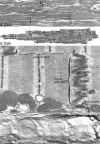The carboxy terminal domain of connexin43: from molecular regulation of the gap junction channel to supramolecular organization of the intercalated disk
- PMID: 18063815
- PMCID: PMC2423487
- DOI: 10.1161/CIRCRESAHA.107.165662
The carboxy terminal domain of connexin43: from molecular regulation of the gap junction channel to supramolecular organization of the intercalated disk
Figures

Comment on
-
C-terminal truncation of connexin43 changes number, size, and localization of cardiac gap junction plaques.Circ Res. 2007 Dec 7;101(12):1283-91. doi: 10.1161/CIRCRESAHA.107.162818. Epub 2007 Oct 11. Circ Res. 2007. PMID: 17932323
References
-
- Severs NJ. Review. The cardiac gap junction and intercalated disc. Int J Cardiol. 1990;26:137–173. - PubMed
-
- Gourdie RG, Green CR, Severs NJ. Gap junction distribution in adult mammalian myocardium revealed by an antipeptide antibody and laser scanning confocal microscopy. J Cell Sci. 1991;99:41–55. - PubMed
-
- Hoyt RH, Cohen ML, Saffitz JE. Distribution and three-dimensional structure of intercellular junctions in canine myocardium. Circ Res. 1989;64:563–574. - PubMed
-
- Severs NJ. Gap junction shape and orientation at the cardiac intercalated disk. Circ Res. 1989;65:1458–1461. - PubMed
-
- Severs NJ, Shovel KS, Slade AM, Powell T, Twist VW, Green CR. Fate of gap junctions in isolated adult mammalian cardiomyocytes. Circ Res. 1989;65:22–42. - PubMed
Publication types
MeSH terms
Substances
Grants and funding
LinkOut - more resources
Full Text Sources
Miscellaneous

